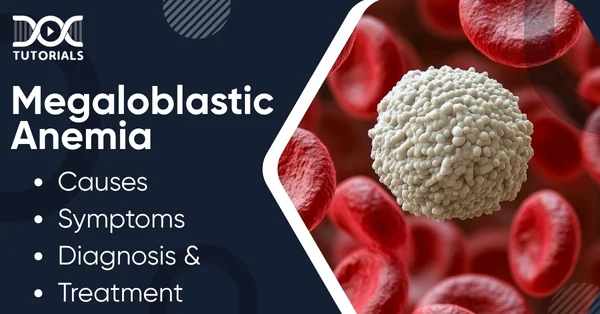Megaloblastic Anaemia: Causes, Symptoms, Diagnosis, and Treatment

Anaemia is a reduction in the circulating blood volume or concentration of haemoglobin. It leads to impairment of the normal oxygen-carrying capacity of blood cells. It is the most common blood disorder, affecting about a third of the global population.
Megaloblastic anemia, including its causes, diagnosis, and treatment options, is significant for NEET PG aspirants. DocTutorials provides a comprehensive learning process with an extensive curriculum and well-curated study resources for the in-depth clarity of pathology, including topics like anaemias.
Keep reading to understand everything about megaloblastic anaemia.
What is Megaloblastic Anaemia?
Megaloblastic anaemia comprises red blood cell disorders characterised by vitamin B12 and folic acid deficiency. The deficiency results in impaired DNA synthesis, ultimately forming abnormally large red blood cell precursors, known as megaloblasts.
The asynchronous maturation between the nucleus and the cytoplasm is the primary cause of the erythroblasts’ large size. A hereditary condition, thiamine-responsive megaloblastic anaemia, is one of the significant conditions associated with megaloblastic anaemia.
What are the Causes of Megaloblastic Anaemia?
The megaloblastic anaemia causes include a deficiency of vitamins and certain intrinsic factors, such as:
- Vitamin B12 Deficiency in Dietary Sources
A vegetarian diet is a significant cause of Vitamin B12 deficiency. Meat, fish, eggs, and dairy products are sources of cobalamin, also known as vitamin B12.
- Vitamin B12 Malabsorption
Some of the reasons for the body’s malabsorption of vitamin B12 are syndromes like Zollinger-Ellison Syndrome, blind loop syndrome, fish tapeworm infestation, and pancreatic insufficiency.
- Inherited Conditions
Congenital conditions like Thiamine-Responsive Megaloblastic Anaemia (TRMA), Imerslund-Grasbeck Syndrome, and Juvenile Megaloblastic Anaemia. Biallelic mutations affect the ileal receptor for the vitamin B12-IF (vitamin B12 and intrinsic factor) complex. Some infants are born with congenital folate malabsorption syndrome.
- Drug-Induced Causes
Some drugs are known to cause induced megaloblastic anaemia in the bone marrow. These drugs include:
- Allopurinol
- Azathioprine
- Capecitabine
- Cladribine
- Fludarabine
- Fluorouracil
- Gadolinium
- Gemcitabine
- Hydroxyurea
- Methotrexate
- Trimethoprim
- Zidovudine
Other drugs that lower intestinal absorption of vitamin B12 and folic acid or impair their metabolism include Aminosalicylic acid, Antacids and PPIs, Oral contraceptives, Metformin, Valproic acid, Phenytoin, and erythromycin.
What are the Risk Factors for Megaloblastic Anemia?
Various lifestyle and dietary factors are risk factors for megaloblastic anaemia. Although these risk factors do not cause anaemia directly, they play a significant role in the onset of the disease.
Some of the risk factors include:
- Gender and genetic factors
- Complete vegetarian diet
- Pregnancy
- Excessive alcohol intake
- Cancer therapy
- Intestinal absorption malfunctions
- Absence or reduced intake of fruits and vegetables in the diet
- Hemodialysis
What are the Symptoms of Megaloblastic Anaemia?
The megaloblastic anaemia symptoms are more or less similar to any other anaemia in the initial stages. These include symptoms like:
- Fatigue
- Breathlessness
- Increased heart rate
- Pallor
- Weakness
As the disease progresses, neurological symptoms start to show up. This is mainly due to a vitamin B12 deficiency.
Neurological symptoms mainly include:
- Numbness in fingers and toes
- Exhaustion
- Tingling sensation in the extremities
- Loss of balance
- Amnesia
- Jaundice
What are the Diagnostic Tests for Megaloblastic Anemia?
Diagnosis for megaloblastic anaemia includes physical examination along with a thorough history taking of the patient. The general physical examination is sufficient to confirm if the patient has anaemia.
To distinguish between the various classes of anaemia, healthcare providers may recommend some tests, such as:
- Complete Blood Count (CBC)
A general blood test to evaluate the haemoglobin concentration and the red blood cell count.
- Peripheral Blood Smear (PBS)
This is a manual test to examine the various blood cells in the body. A small drop of blood is taken onto a glass slide, and a smear is prepared. This smear is then manually examined under a microscope. The PBS helps to confirm abnormalities in cell shape and size.
- Reticulocyte Count
This test calculates the number of precursor red blood cells (reticulocytes) in the bone marrow and evaluates the blood cell production capacity of the bone marrow in the body.
What are the Treatment Options for Megaloblastic Anaemia?
The megaloblastic anaemia treatment includes both prevention and management. Prevention includes lifestyle modifications to avoid the disease if the risk factors are already present.
On the other hand, management involves administering drugs intended to improve the patient’s condition.
Prevention Tips for Megaloblastic Anaemia
- Maintain a healthy diet that includes all the necessary macro- and micronutrients.
- Keep the alcohol intake in check.
- Add fortified foods to the diet.
Management Tips for Megablastic Anaemia
- Management of Vitamin B12 Deficiency: Healthcare providers may recommend vitamin B12 injections for acute cases so that vitamin B12 levels may return to normal as soon as possible. For chronic cases, vitamin B12 supplements may be recommended every month or for a lifetime, depending on the body’s ability to absorb vitamin B12.
- Management of Folic Acid (Vitamin B9) Deficiency: Sometimes, vitamin B9 may be prescribed along with treatment for vitamin B12 deficiency. Vitamin B9 supplements alone can be a catastrophe if there is an underlying vitamin B12 deficiency. The anaemia may be corrected, but the neurological symptoms will persist.
FAQs about Megaloblastic Anaemia
- What are the major causes of megaloblastic anaemia?
The leading causes of megaloblastic anaemia include a deficiency of vitamin B12 or folate. The other reason can be intestinal malabsorption.
- What are the 5 characteristic symptoms of anaemia?
The 5 characteristic symptoms of anaemia include fatigue, pallor, shortness of breath, dizziness, and tachycardia.
- What is the ideal range of MCV for an adult human?
An adult human’s Mean Corpuscular Volume (MCV) should be 80 to 100 femtolitres (fL).
- Which dietary sources are rich in vitamin B12?
Dietary sources rich in vitamin B12 include meat, liver, seafood, eggs, and dairy products.
Conclusion
Megaloblastic anaemia is an essential topic for the upcoming NEET PG exam. Aspiring medical professionals like you must know about its various aspects. At DocTutorials, you can find detailed lectures about other important topics, such as megaloblastic anaemia. These resources are fundamental to ace any professional medical exam.
Want to secure top rank in NEET PG? Enrol in our NEET PG course today!
Latest Blogs
-

INI CET Exam 2025: Your Roadmap to Success – Key Topics, Strategies, and Lessons from Last Year’s Papers
The INI CET exam is more than just a test; it’s a significant milestone for many medical students aiming to…
-

INI CET Exam Success: Previous Year Question Papers & Ultimate Guide – INI CET PYQ
One can feel overwhelmed while preparing for the INI CET (Institute of National Importance Combined Entrance Test). A vast syllabus,…
-

INI CET Exam Pattern 2024: A Complete Guide with Subject-Wise Weightage
The Institute of National Importance Combined Entrance Test (INI CET) is your key to entering some of the most prestigious…




